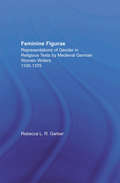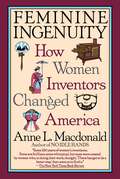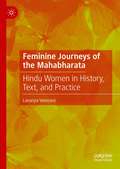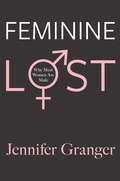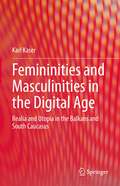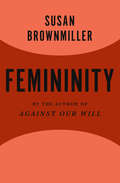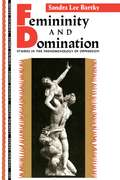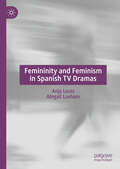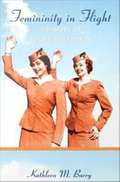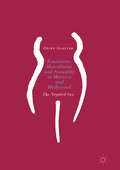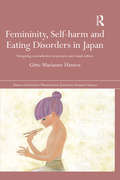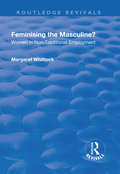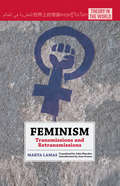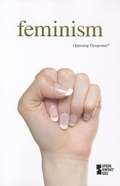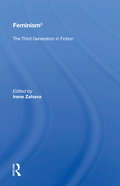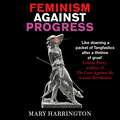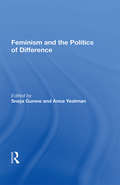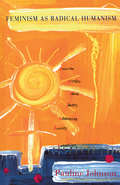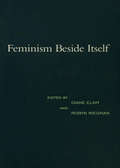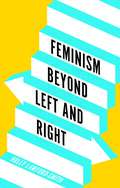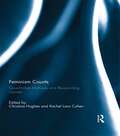- Table View
- List View
Feminine Figurae: Representations of Gender in Religious Texts by Medieval German Women Writers, 1100-1475 (Studies in Medieval History and Culture #10)
by Rebecca L.R. GarberFirst Published in 2003. Routledge is an imprint of Taylor & Francis, an informa company.
Feminine Ingenuity: Women and Invention in America
by Anne Macdonald"Written with clarity and a lively eye both for detail and for the progress of feminism in the United States."SAN FRANCISCO CHRONICLEIn this fascinating study of American women inventors, historian Anne Macdonald shows how creative, resourceful, and entrepreneurial women helped to shatter the ancient stereotypes of mechanically inept womanhood. In presenting their stories, Anne Macdonald's thorough research in patent archives and her engaging use of period magazine, journals, lectures, records from major fairs and expositions, and interviews, have made her book nothing less than an overall history of the women's movement in America.From the Trade Paperback edition.
Feminine Journeys of the Mahabharata: Hindu Women in History, Text, and Practice
by Lavanya VemsaniThe Mahabharata preserves powerful journeys of women recognized as the feminine divine and the feminine heroic in the larger culture of India. Each journey upholds the unique aspects of women's life. This book analytically examines the narratives of eleven women from the Mahabharata in the historical context as well as in association with religious and cultural practices. Lavanya Vemsani brings together history, myth, religion, and practice to arrive at a comprehensive understanding of the history of Hindu women, as well as their significance within religious Indian culture. Additionally, Vemsani provides important perspective for understanding the enduring legacy of these women in popular culture and modern society.
Feminine Lost: Why Most Women are Male
by Jennifer GrangerFeminine Lost explores the premise that all human beings are constructed of two energies, one masculine and one feminine. With the rise of the feminist movement, many women have migrated to their masculine side, some to the extent of losing access to their feminine side altogether. As a consequence, men have found their way to their feminine side. This process has had huge consequences for relationships between men and women, often leaving them feeling unsatisfied within their relationships or lonely without one. Feminine Lost examines female archetypes - the Andro Woman, the Cougar, the Good Doer, and more - that have come to the fore since the feminist movement, pairing them with their masculine opposite, and looking at how the process of attraction functions under these circumstances. When the feminine principle breaks down, the ramifications are many. Feminine Lost breaks through the misunderstanding of what it means to be feminine; it is not an outward appearance but something far more significant.
Femininities and Masculinities in the Digital Age: Realia and Utopia in the Balkans and South Caucasus
by Karl KaserThis book provides a fresh overview on the debate about the remarkable regression of gender equality in the Balkans and South Caucasus caused by the fall of socialism and by the revitalization of religion in Turkey. Contrary to the prevailing opinion of researchers who state continuous male domination, the book presents strong arguments for an alternative outlook. By contrasting the realia of gender relations with the utopia of new femininities and new masculinities driven by digital visual communication, the book provokingly concludes with the arrival of two utopias: the Marlboro Man – still authoritative but lonely – conquering and refusing family obligations; and with the emergence of a new femininity type – strong and beautiful. As such this book provides a great resource to anthropologists, demographers, sociologists, gender and media researchers and all those interested in feminist issues.
Femininity
by Susan BrownmillerWith intelligence and humor, Susan Brownmiller explores the history and unspoken rules of the burden of &“feminine perfection&” What is femininity? How is it measured? What are its demands? How are women meant to dress, look, think, act, feel, and be, according to the mores of society? Susan Brownmiller offers a witty and often pointed critique of the concept of femininity in contemporary culture and throughout history. She explores the demands placed upon women to fit an established mold, examines female stereotypes, and celebrates the hard-won advances in women&’s lifestyle and attire. At once profound, revolutionary, empowering, and entertaining, Femininity challenges the accepted female norm while appreciating the women throughout history who have courageously broken free of its constraints.
Femininity Played Straight: The Significance of Being Lesbian
by Biddy MartinIn Femininity Played Straight, Biddy Martin traces the changing relations of lesbianism and feminist theory from the late 1970s to the present. These sparkling essays argue for accounts of sexuality, gender and subjectivity that make lesbianism intelligible and important, for lesbians and non-lesbians alike. Moving between theoretical and autobiographical modes, Biddy Martin brings different kinds of writing to bear upon one another. At a theoretical level, her work takes issue with postmodern theory, defending instead the role of psychoanalytic criticism. She argues for the continued validity of critical modes that do not abandon the unconscious in seeking to understand the relation of subjectivity to language. In so doing, she addresses the work of writers, thinkers and activists as varied as Mary Daly, Michel Foucault, Adrienne Rich, Gayle Rubin, Minnie Bruce Pratt, Sigmund Freud, Eve Kosofsky Sedgwick, Audre Lorde, Judith Butler, and Joan Copjec.
Femininity and Domination: Studies in the Phenomenology of Oppression
by Sandra Lee BartkyBartky draws on the experience of daily life to unmask the many disguises by which intimations of inferiority are visited upon women. She critiques both the male bias of current theory and the debilitating dominion held by notions of "proper femininity" over women and their bodies in patriarchal culture.
Femininity and Feminism in Spanish TV Dramas
by Anja Louis Abigail LoxhamRecent social and political events in Spain have prompted a resurgence of feminism in the Spanish public sphere. Popular culture intervenes in these debates, and television does so specifically through the dramas which foreground female stories and female subjects, in many cases redefining and interpreting key moments in the progression of national gender politics. This pioneering study maps these developing concerns onto a selection of TV dramas which centre on feminisms and female identities, and as such are key interlocutors in social change. Our intention is to mainstream Spanish television studies and, in our analysis of its innovative and varied approach to gender politics, to take it out of the ‘interpretative isolation ward’ (Smith 2006). This monograph fills a significant gap in the literature on transnational popular culture; it is ground-breaking in its interdisciplinarity (television, modern languages, gender studies) and is the first of its kind in English.
Femininity in Flight: A History of Flight Attendants
by Kathleen M. Barry"In her new chic outfit, she looks like anything but a stewardess working. But work she does. Hard, too. And you hardly know it. " So read the text of a 1969 newspaper advertisement for Delta Airlines featuring a picture of a brightly smiling blond stewardess striding confidently down the aisle of an airplane cabin to deliver a meal. From the moment the first stewardesses took flight in 1930, flight attendants became glamorous icons of femininity. For decades, airlines hired only young, attractive, unmarried white women. They marketed passenger service aloft as an essentially feminine exercise in exuding charm, looking fabulous, and providing comfort. The actual work that flight attendants did--ensuring passenger safety, assuaging fears, serving food and drinks, all while conforming to airlines' strict rules about appearance--was supposed to appear effortless; the better that stewardesses performed by airline standards, the more hidden were their skills and labor. Yet today flight attendants are acknowledged safety experts; they have their own unions. Gone are the no-marriage rules, the mandates to retire by thirty-two. In Femininity in Flight, Kathleen M. Barry tells the history of flight attendants, tracing the evolution of their glamorized image as ideal women and their activism as trade unionists and feminists. Barry argues that largely because their glamour obscured their labor, flight attendants unionized in the late 1940s and 1950s to demand recognition and respect as workers and self-styled professionals. In the 1960s and 1970s, flight attendants were one of the first groups to take advantage of new laws prohibiting sex discrimination. Their challenges to airlines' restrictive employment policies and exploitive marketing practices (involving skimpy uniforms and provocative slogans such as "fly me") made them high-profile critics of the cultural mystification and economic devaluing of "women's work. " Barry combines attention to the political economy and technology of the airline industry with perceptive readings of popular culture, newspapers, industry publications, and first-person accounts. In so doing, she provides a potent mix of social and cultural history and a major contribution to the history of women's work and working women's activism.
Femininity, Masculinity, and Sexuality in Morocco and Hollywood
by Osire GlacierThis book is the first to formulate an ideology of emancipation for women in Morocco. Beginning with constructs of the body, femininity and masculinity, it analyzes the central role played by the sociopolitical writing of sexuality in creating gender hierarchy. The author focuses on Morocco, while drawing parallels with Hollywood cinema, one of the great producers of femininity and masculinity, and conducts an exhaustive examination of constructs of femininity and masculinity in language, social practices, cultural productions and legal texts. The objectives of this project are tripartite: it exposes the dynamics that devalue women's humanity; it charts the schemas of their sexual, economic and sociopolitical exploitation; and it advances concrete solutions for re-establishing women's human dignity.
Femininity, Self-harm and Eating Disorders in Japan: Navigating contradiction in narrative and visual culture (Nissan Institute/Routledge Japanese Studies)
by Gitte Marianne HansenFrom the 1980s onwards, the incidence of eating disorders and self-harm has increased among Japanese women, who report receiving mixed messages about how to be women. Mirroring this, women’s self-directed violence has increasingly been thematised in diverse Japanese narrative and visual culture. This book examines the relationship between normative femininity and women’s self-directed violence in contemporary Japanese culture. To theoretically define the complexities that constitute normativity, the book develops the concept of ‘contradictive femininity’ and shows how in Japanese culture, women’s paradoxical roles are thematised through three character construction techniques, broadly derived from the doppelgänger motif. It then demonstrates how eating disorders and self-harm are included in normative femininity and suggests that such self-directed violence can be interpreted as coping strategies to overcome feelings of fragmentation related to contradictive femininity. Looking at novels, artwork, manga, anime, TV dramas and news stories, the book analyses both globally well known Japanese culture such as Murakami Haruki’s literary works and Miyazaki Hayao’s animation, as well as culture unavailable to non-Japanese readers. The aim of juxtaposing such diverse narrative and visual culture is to map common storylines and thematisation techniques about normative femininity, self-harm and eating disorders. Furthermore, it shows how women’s private struggles with their own bodies have become public discourse available for consumption as entertainment and lifestyle products. Highly interdisciplinary, it will be of huge interest to students and scholars of Japanese studies, Japanese culture and society and gender and women's studies, as well as to academics and consumers of Japanese literature, manga and animation.
Femininity: The Enigma of Gender Identity
by Riccardo DriIn this thought-provoking book, the author explores the intricate dynamics of gender identity, challenging conventional ideas about what defines being a man or a woman. The narrative underscores the critical distinction between sex—biological differences—
Feminising the Masculine?: Women in Non-traditional Employment (Routledge Revivals)
by Margaret WhittockThis title was first published in 2000: This work aims to provide a comparative and temporal assessment of the position of women in non-traditional employment in Europe, Britain and Northern Ireland. Its second aim is to provide a new perspective on the division of labour in modern Western societies and to critically examine the issues, debates and perspectives which have traditionally dominated portrayals of women and paid employment. The book assesses the potential which women themselves have for transforming existing gender relations, particularly within the structural constraints of the education, training and employment systems. In so doing, it is intended to highlight flaws inherent in much contemporary feminist theorizing, and aims to provide a more satisfactory theoretical framework within which to elaborate and develop its arguments. While related texts have tended to concentrate on stereotypical notions of women and paid employment, this book aims to fill a gap in the literature by scrutinizing the lived experiences of women in non-traditional manual occupations, and relating these to a possible transformation of the existing gender order in Western societies
Feminism
by Marta LamasAdding to the debate on a range of issues, this book presents a critical and deeply personal history of Mexican feminism in the last thirty five years. Drawing from her many years of activism and anthropological scholarship, influential thinker Marta Lamas covers topics such as the political development of the feminist movement, affirmative action in the workplace, conceptual advances in regard to gender, and disagreements among feminists. Here in English for the first time, this work offers invaluable insight into the theoretical and political tensions that have shaped Mexican feminism and the world at large.
Feminism
by Nancy DziedzicThis book is one volume of the highly acclaimed Opposing Viewpoints Series developed by Greenhaven Press focusing on feminism.
Feminism & Autobiography: Texts, Theories, Methods (Transformations)
by Celia Lury Penny Summerfield Tess CoslettFeaturing essays by leading feminist scholars from a variety of disciplines, this key text explores the latest developments in autobiographical studies. The collection is structured around the inter-linked concepts of genre, inter-subjectivity and memory. Whilst exemplifying the very different levels of autobiographical activity going on in feminist studies, the contributions chart a movement from autobiography as genre to autobiography as cultural practice, and from the analysis of autobiographical texts to a preoccupation with autobiography as method.
Feminism - The Essential Historical Writings
by Miriam SchneirThe vast majority of women are unaware of the great feminist writings of the past.
Feminism 3: The Third Generation In Fiction
by Irene ZahavaThis book is a collection of short stories by third generation feminists, covering major issues in a young woman's life: awakening sexuality, biological and psychological landmarks, family rejection and rebellion, child abduction and abuse, gender identification, and sexual harassment.
Feminism Against Progress
by Mary HarringtonIn Feminism Against Progress, Mary Harrington argues that the industrial-era faith in progress is turning against all but a tiny elite of women. Women's liberation was less the result of human moral progress than an effect of the material consequences of the Industrial Revolution. We've now left the industrial era for the age of AI, biotech and all-pervasive computing. As a result, technology is liberating us from natural limits and embodied sex differences. Although this shift benefits a small class of successful professional women, it also makes it easier to commodify women's bodies, human intimacy and female reproductive abilities.This is a stark warning against a dystopian future whereby poor women become little more than convenient sources of body parts to be harvested and wombs to be rented by the rich. Progress has now stopped benefiting the majority of women, and only a feminism that is sceptical of it can truly defend female interests in the 21st century
Feminism And The Politics Of Difference
by Anna Yeatman Sneja GunewVersions of Jacki Huggins's 'Pretty deadly tidda business' have appeared in Hecate vol. 17, no. 1; 1991, I lndyk, ed.; Memory (Southerly 3, 1991) HarperCollins, Sydney, 1991; Second Degree Tampering, Sybylla Feminist Press, Melbourne, 1992. Laleen Jayamanne's 'Love me tender, love me true ... ' was first published in Framework 38139, 1992. A version of Smaro Kamboureli's 'Of black angels and melancholy lovers' appeared in Freelance (Saskatchewan Writers' Guild), xxi, 5 (Dec. 1991-Jan. 1992). Roxana Ng's 'Sexism, racism and Canadian nationalism' appeared in Race, Class, Gender: Bonds and Barriers, Socialist Studies/Etudes Socialistes: A Canadian Annual no. 5, 1989. Trinh Minh-ha's 'All-owning spectatorship' has also appeared in her collection of essays When the Moon Waxes Red, Routledge, NY, 1991.
Feminism As Radical Humanism
by Pauline JohnsonFeminism is currently at an impasse. Both the liberation feminism of the 1970's and the more recent feminism of difference are increasingly faced with the limitations of their own perspectives. While feminists today generally acknowledge the need to recognise diversity, they lack a coherent framework through which this need can be articulated. In "Feminism as Radical Humanism", Pauline Johnson calls for a reassessment of feminism's relationship to modern humanism. She argues that despite its very thorough and necessary critique of mainstream formulations of humanist ideals, feminism itself remains strongly committed to humanist values. Drawing on a broad range of political and intellectual traditions, Johnson demonstrates that, only by proudly affirming its own humanist commitments can feminist theory find a way to negotiate the impasse in which it currently finds itself. "Feminism as Radical Humanism" is an important and controversial contribution to feminist theory, and to the ongoing debate about the meaning of contemporary humanism.
Feminism Beside Itself
by Robyn Wiegman Diane ElanFirst published in 1995. Routledge is an imprint of Taylor & Francis, an informa company.
Feminism Beyond Left and Right
by Holly Lawford-SmithAn unquestioned assumption of contemporary politics is that the left owns minority groups, in the sense that the left, exclusively, champions the interests of minorities and is for that reason owed the allegiance of minorities. This, in turn, gives rise to the sense of dissonance created by right-wing dissenters—the black social conservative, the gay ultra-nationalist, the female libertarian, the poor pro-capitalist. This same dissonance exists for women and feminism, creating a default assumption that a feminist is a left-wing woman. We don’t make a distinction between left-wing feminists and feminists; we don’t need to.There’s nothing a philosopher loves more than an unquestioned assumption, and in this book political philosopher Holly Lawford-Smith systematically dismantles the assumption that feminism is an exclusively left-wing project. Once dismantled, the path is clear to a new set of questions. Who counts as a feminist in the first place? If women from anywhere on the political spectrum can be feminists, who is it that feminists should—or shouldn't—be working with? And what can be said, more generally, about the ethics of alliances and coalitions?In Feminism Beyond Left and Right Lawford-Smith makes the case for non-partisan feminism, feminism outside the constraints of the left-right political spectrum, a feminism for and about all women as women.
Feminism Counts: Quantitative Methods and Researching Gender
by Rachel Lara Cohen Christina HughesThis is an important and timely text that provides a unique overview of contemporary quantitative approaches to gender research. The contributors are internationally recognised researchers from the UK, USA and Sweden who occupy a range of disciplinary locations, including historical demography, sociology and policy studies. Their research includes explorations of heterosexual and same sex violence, media responses to feminist research, data sources for the study of equalities, approaches for analysing global and local demographic change and intersectional concerns in respect of work and employment.Through detailed, sophisticated and thoughtful considerations of the place of quantification within gender studies, and the place of feminist approaches to quantification, each contributor overturns the stereotype that quantitative research is antithetical to feminism by demonstrating its importance for challenging continuing global inequalities associated with gendered outcomes. An introductory chapter illustrates the significance of geography and discipline in the take-up of methodological preferences.Feminism Counts: Quantitative Methods and Researching Gender makes an important contribution to the ways in which feminists respond to contemporary methodological and interdisciplinary challenges, and is essential reading for all research students in gender studies.This book was originally published as a special issue of the International Journal of Social Research Methodology.
